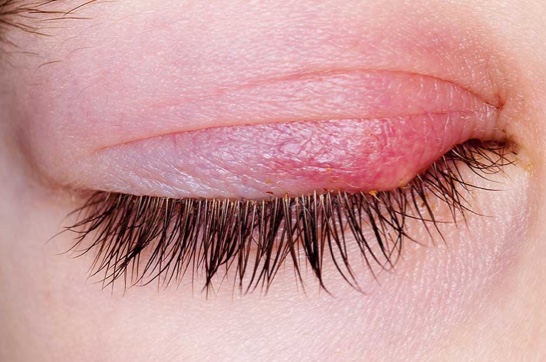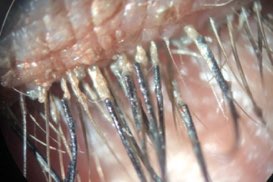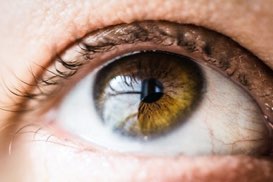by Darrell E. White, MD
Ocular Surgery News U.S. Edition, January 25, 2017
When you think about dry eye, whether or not you treat dry eye, there is a certain image that jumps to mind. For some of you, it is the classic image of an older patient gently rocking in a chair on the porch with his nose buried in a Zane Grey novel. After an hour or two, he starts to squint, rub his eyes, dab his cheekbones and then eventually quit as his eyes become drier with each turn of the page. Others among you, likely those who have done some dry eye treatment in the Age of Restasis, have a picture of the classic Allergan archetype pop-up: a woman between the ages of 35 and 60 years who has dryness, scratchiness and generally miserable feeling eyes. At SkyVision, we know her as Linda Blair.
Those of you who are newer to the community of DED docs in this new Age of Xiidra (welcome aboard, Steve Lane!) have their antennae up and are on the lookout for patients who spend lots of time in front of some kind of computer screen. The combination of increased screen time of all types and the endless folly of the USDA dietary recommendations has created a whole new class of DED patients. The “poster child” for this group is the Millennial living the so-called “multi-screen” life both at work and at play. What you probably do not think of, however, is the pediatric age group.
The reality is that if you take care of kids, you are soon to be a pediatric DED doc.
Pediatric dry eye disease
To be sure, there have always been kids who have suffered from some type of dry eye, but they have been rather few and somewhat far between. These kids often had something else going on. Perhaps it was severe allergies with dryness resulting from very aggressive antihistamine use. Atopic conjunctivitis quite often caused a type of dry eye. In cases such as these, we are able to identify a discrete underlying cause that we can either treat or simply wait out. The primary pediatric DED patient was a bit of a unicorn in all but the most specialized clinics. Sadly, this is no longer the case.
At SkyVision a few years ago, we started to notice a very definite uptick in high school and college kids who were coming to the office with classic complaints of DED. The first cases had a “tell”: The kids were vegetarians or vegans with little or no omega-3 fatty acid intake. Soon enough, though, it was a much more heterogeneous group. If you just looked at the history and the objective data that we gathered, but did not look at the date of birth, you would swear that you were looking at the chart of a 45-year-old accountant. Seriously, it was eerie. Blurry vision that fluctuated, especially at near. Red, painful eyes that burned, with symptoms increasing over the course of the day. Tearing that interfered with their favorite activities especially — wait for it — looking at their smartphones.
We have now expanded our criteria to evaluate DED to include patients who are in high school and older. Kids and young adults who come to the office with a complaint of blurry vision are given an OSDI to fill out while they wait for their exam. Just like any other potential DED patient, our technicians will obtain a tear osmolarity measurement (TearLab) and determine if there is any MMP-9 activity on the ocular surface (InflammaDry, RPS). We look for fluorescein staining and measure tear breakup time; these are abnormal in a surprising number of young people.
Our epiphany occurred when we started to image the meibomian glands in these younger patients using LipiView and LipiScan from TearScience. Quite simply, we were astonished at both the frequency that we found meibomian gland disease in these young patients and the severity of both the obstruction and destruction that the imaging uncovered. All kinds of very important questions arise. Why is this happening? Has it always been there and we have just not seen it because we did not have the technology necessary to make the diagnosis? Is there a hereditary component at play? Is this simply the logical extension of evaporative DED into an ever-younger cohort of individuals living a multi-screen life?
Lifestyle-driven pathology
Happily for your faithful scribe and this article, but sadly for our pediatric and younger patients, my friend Dave Granet at UCSD sent along an article that is highly suggestive that this is a mostly lifestyle-driven pathology. Moon and colleagues looked at smartphone use and DED in two cohorts of grade school children in Korea. That is not a typo. Grade. School. Children. The kids were divided into an older group (grades 4-6) and a younger group (grades 1-3). Smartphone use and outdoor play hours were recorded, and a modified OSDI was used to detect DED symptoms. Each child was examined for clinical signs of DED, such as staining and rapid tear breakup time.
Nine percent of the older children were diagnosed with DED, as well as 4% of the younger children. There was a strong correlation between duration of smartphone use and DED and a negative correlation with outdoor play (more outdoor play means less likely to have DED). When the children with DED had their use of a smartphone restricted for 4 weeks, there was a dramatic and significant decrease in both signs and symptoms of DED.
Seriously. Grade school children.
What does this mean for us, the eye doctors who see kids? Well, for certain we all need to be thinking about MGD and DED in even the youngest patients we see when they present with symptoms of DED. I think that meibomian gland imaging is something that is going to be ever more important. By extension we are going to be obligated to offer these kids treatment so that they do not come to our attention at age 25 with totally smoked glands and nothing but “save the tissue remaining” options. That means LipiFlow (TearScience) in kids. That means chronic, ongoing AzaSite (azithromycin ophthalmic solution, Akorn) treatment. That means aggressive nutritional counseling and therapy. Will we see a different response to these therapies in kids, maybe even a return to more normal glands with treatment? I guess we will see. Someone needs to do some research on that.
Evaporative DED associated with smartphone use is a lifestyle disease. It is up to us to begin the arduous process of educating a populace that desperately does not want to know. Maybe once they are aware that it is affecting kids, we will get their attention.








